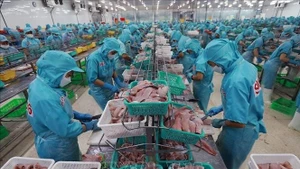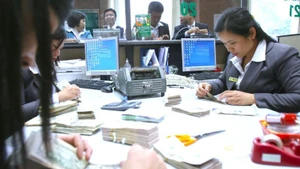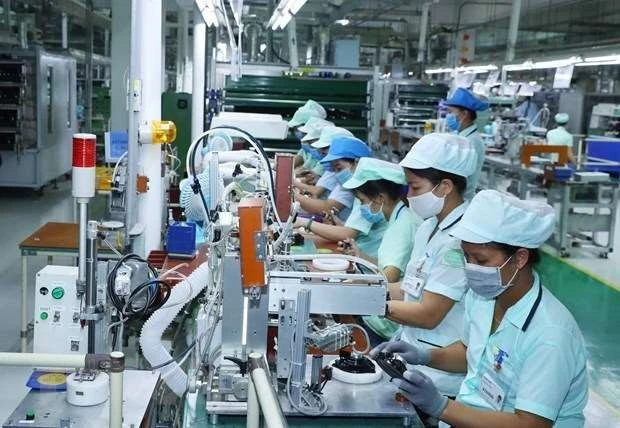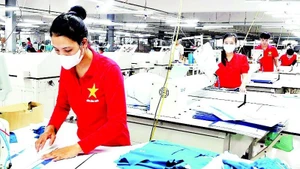After the first quarter recorded a GDP growth rate of 5.66%, the Ministry of Planning and Investment (MPI) has updated two economic growth scenarios for 2024. Specifically, under scenario 1, the annual economic growth is expected to reach 6%, which was the lower end of the target set by the National Assembly (NA). To achieve this figure, the economy must grow by about 6.12% over the next nine months — with the growth rate at 5.85% in the second quarter, 6.22% in the third quarter, and 6.28% in the fourth quarter, reaching or falling slightly below the scenarios outlined in the Government’s Resolution No.01.
Under scenario 2, the annual economic growth could reach 6.5%, the upper end of the target set by the NA. Accordingly, the economy must grow by about 6.75% over the next nine months, with 6.32% in the second quarter, 6.79% in the third quarter by, and 7.08% in the fourth quarter. Quarterly growth rates would be approximately 0.1 percentage points higher than the upper end of the scenarios outlined in the Government’s Resolution No.01.
Annual GDP growth could reach 7%
Regarding the business and production results in the first six months of 2024, Cao Huu Hieu, General Director of the Vietnam National Textile and Garment Group (Vinatex), stated that compared to the same period in 2023, the orders in early 2024 have increased and the order placement periods have been longer. Most of the Group's garment companies have sufficient orders until October and are negotiating orders for the following months. Vietnam's textile and garment industry has risen to the top of the market share in exporting garments to the US, surpassing China, and has the highest growth among the top three textile and garment exporting countries in the world.
Hieu noted: “The improvement in Vietnam's textile and garment exports has not come from an increase in global demand for textiles but thanks to a certain shift of orders from other countries to Vietnam, in combination with the advantage of the exchange rate since the beginning of the year while the currencies of competing countries have remained almost unchanged against the USD.”
Bui Huy Son, Director of the Planning and Finance Department under the Ministry of Industry and Trade (MoIT), noted that exports in the first half of the year recorded a strong recovery. The export turnover in the first six months is estimated to have reached nearly 189 billion USD, an increase of 13.8% compared to the same period in 2023. Notably, the export turnover of the key commodity of processed and manufactured industrial products was estimated at nearly 160 billion USD, accounting for 84.6% of total export turnover and increasing by 13.8% compared to the same period in 2023, with many commodities such as cameras, camcorders, computers, electronic products, and components experiencing high growth in the first five months.
Vietnam's major export markets, including the US, China, the EU, and the Republic of Korea (RoK), have all recorded high growth. In particular, exports to the US are estimated to have reached 43.98 billion USD, a year-on-year increase of 21%. Exports to China reached 22.65 billion USD, up 10.2%; to the EU reached 20.69 billion USD, up 16.1%; and to the RoK hit 10.4 billion USD, up 12.8%.
With these positive signals, the BIDV Training and Research Institute assessed that GDP growth in the second quarter would continue to remain positive, potentially reaching 5.9 - 6.3%, helping the GDP in the first half of 2024 increase by 5.8 - 6.2%. BIDV's chief economist Can Van Luc was more "confident", predicting that GDP could increase by 6 - 6.5% in 2024 according to the baseline scenario to meet the targets set by the NA and the Government, or it could be more optimistic at around 6.5 - 7% in the positive scenario.
Dealing with difficulties
To achieve the growth targets, Luc said the ministries, sectors, and localities need to accelerate the completion of institutions and create a favourable environment for promoting growth and stabilising the macroeconomy, while focusing on issuing and effectively implementing policies and measures to remove obstacles (especially in legal issues, land valuation, VAT refunds, access to capital, and social housing development). The relevant agencies and localities should also soon issue decrees and circulars to ensure the consistency and synchrony with the laws passed by the NA to address overlaps and obstacles, ensuring enforcement effectiveness; and promptly issue institutions and legal frameworks to facilitate the development of the digital economy, green economy, circular economy, and energy transition.
In addition, fiscal policy will need to play a key role and should be expanded with a focus on key areas, in combination with accelerating the disbursement of public investment and policies on tax exemptions, deferrals, and delays similar to in 2023. Monetary policy plays a supportive role in a proactive and flexible manner towards increasing credit access while controlling risks and handling bad debts and paying attention to the control of systemic risk. At the same time, circulars on lending, corporate bond investment, and debt restructuring should be promptly amended to help remove obstacles and increase the initiative for credit institutions and borrowers.
Regarding the MoIT, Bui Huy Son noted that the second half of 2024 still poses many challenges for production and export activities due to ongoing geopolitical conflicts driving up transport costs as well as dependence of the import and export activities on certain markets, products, and foreign investment areas. Moreover, key export products to major markets such as the EU and the US continue to face pressures from trade defence investigations, technical barriers related to the environment, sustainable development, and green transition.
However, with a system of free trade agreements covering more than 60 markets, opportunities are still open for domestic industries and businesses to boost exports and take advantage of tariff incentives. Therefore, the Ministry will strongly carry out solutions to clear production bottlenecks, develop a stable supply source for exports and the domestic market, and ensure energy security. It will focus on market solutions, boosting exports and domestic consumption, and effectively controlling imports and the quality of goods circulating in the market.
From the perspective of businesses, General Director of Vinatex Cao Huu Hieu said the group will take advantage of opportunities from the market and identify products with complex technical requirements and small orders with high added value for production, rather than common low-cost products that are difficult to compete. The business will regularly monitor and update market information, forecast potential scenarios, and develop appropriate plans for production and business activities. In addition to complying with environmental technical requirements and labour welfare policies, it is necessary to continue modernising the management model to ensure the harmonious interests of shareholders, society, and workers, as well as to transparently provide supply chain traceability information.
Hieu expressed his hope that “with the fundamental solutions, along with more positive signals from the market, especially in the yarn sector in the second half of 2024, the production and business results will be better... The export turnover of Vietnam's textile and garment industry is expected to increase by 8-10% compared to 2023.”
















